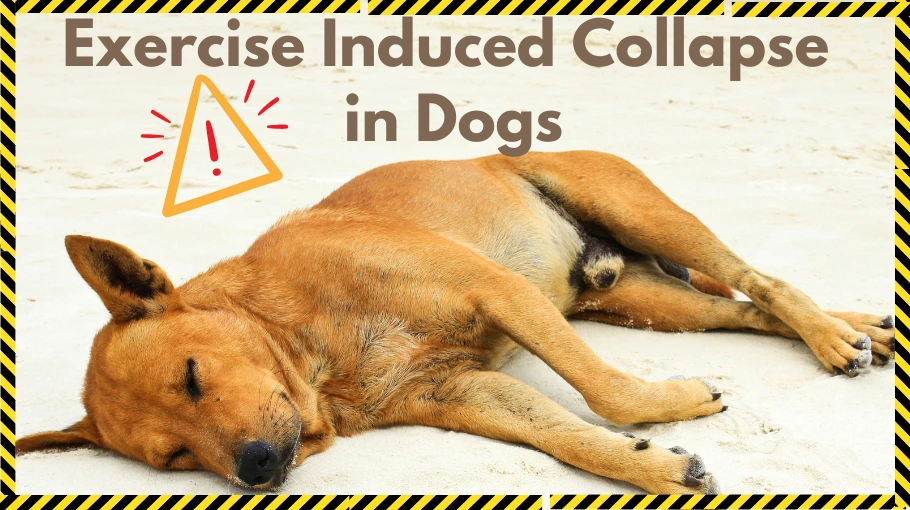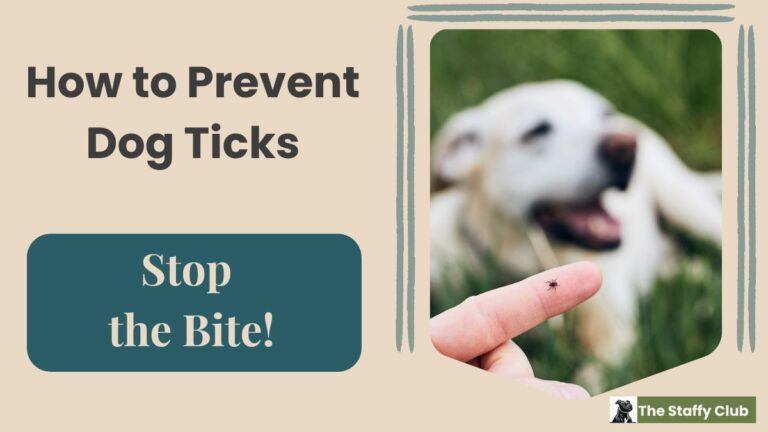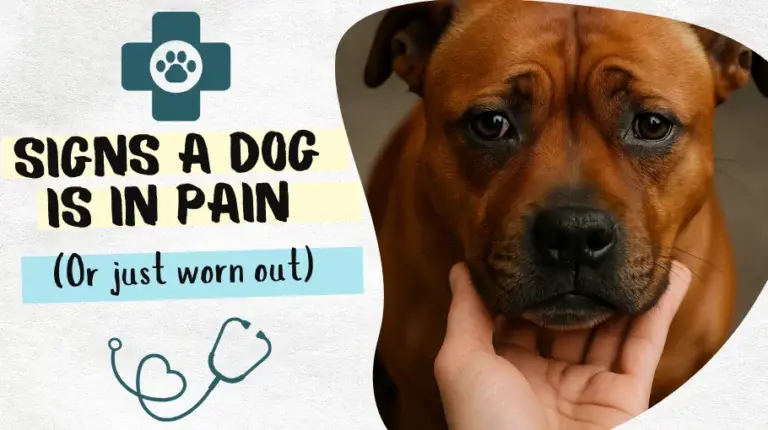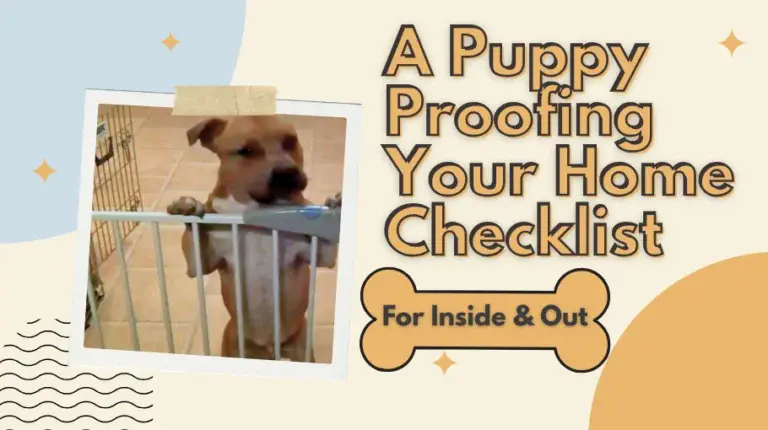Exercise Induced Collapse in Dogs or Overdoing It: Real Talk

Just heard of exercise-induced collapse in dogs? Let me break it down — what I’ve learned, what I look for now, and why I keep a closer eye on how my dogs handle hikes.
Now, full disclosure: I’m not a vet. Just a guy with two Staffies and a few uh-oh moments on long walks when things got too hot, too fast.
So here’s the thing: I thought I knew what Exercise-Induced Collapse was. Turns out, I was wrong. It’s not as it sounds.
Like I’m sure a lot of dog owners will, I assumed it was just a dramatic term for when a dog overdoes it — too much running, too hot, too fast. That is what it sounds like, right? But the actual condition, Exercise-Induced Collapse (EIC), is a genetic disorder, and it’s not the same thing as just overheating or overexertion.
Table of Contents
So, What is Exercise-Induced Collapse in Dogs? Understanding the Genetic Disorder
In a nutshell, exercise-induced collapse(EIC) is when a dog’s nervous system short-circuits during or after intense exercise. Their back legs might give out, they get wobbly, and sometimes they just collapse altogether. You’re left standing there with a tennis ball thinking, “What the heck just happened?”
It’s most common in high-energy, athletic breeds — like Labs, Border Collies, and (though not as often) our beloved Staffies. These dogs are all gas, no brakes — even when their body is throwing up warning signs. But here’s the thing: EIC doesn’t necessarily happen because the dog is overexerted. It’s a genetic disorder, so it can occur regardless of how much or how little exercise they’ve had.
Here’s the kicker: EIC is genetic.
Researchers have identified a mutation in a gene called DNM1 that messes with how nerves communicate with muscles. Basically, it’s like the wiring gets fried when the dog exerts itself too much. Some dogs are just carriers, others are affected — but most look perfectly normal… until they’re not.
And yep, science has been all over this. Shout-out to researchers who first spotted it in hunting Labradors. Since then, more breeds are identified as at risk of EIC — especially the kind who charge headfirst into play mode without a second thought.
Watch as a Vet Explains Exercise Induced Collapse in Dogs
In this video, a veterinarian (Jan Rogers) explains the science behind EIC, its symptoms, and how it affects dogs. If you’re looking for a deeper dive into the condition from an expert, this 10-minute talk is a must-watch!
Click here to watch the video on YouTube
(Save it for later or watch it in the YouTube app when you have time!)
What It Can Look Like in Real Life
So, if you’re picturing a dramatic collapse mid-run — that *can* happen… but not always.
EIC can creep in more subtly. It might start with a wobble in the back legs. Your dog could look a little off-balance, like they’ve just overdone it on the zoomies. Their breathing may pick up, and then — boom — they plop down like they hit an invisible wall.
Sometimes, they pop back up a few minutes later and act like nothing happened. But even if they bounce back, it’s still a sign their system hit overload. Don’t brush it off — whether it’s overexertion, overheating, or EIC, it’s worth a conversation with your vet. There are DNA tests that can check for the DNM1 gene linked to EIC.
As for me? I’ve learned to let my dogs set the pace. If you’ve ever wondered how much exercise is too much, check this out: How long to walk a dog: (How much is too much?)
If they slow down or flop, that’s my cue to chill too. I’ll let them rest in the shade (because their coats can heat up quick). My black Staffy overheats faster than a pizza in a microwave (thanks, dark coat). He’s quick to let me know when he’s had enough. My white Staffy, though? Way more “Zen.” He’ll just casually pause in the shade like he’s practicing mindfulness — definitely not struggling, no sir. Just… enjoying the breeze.
One time, we were out on this open trail — not a single tree, not even a polite bush. And sure enough, my guy needed a break.
So there I am: hoodie off, backpack propped up, knees awkwardly bent like a human tent pole, trying to make a shady nook. One Staffy dove in immediately. The other hovered like, “Hmm… this doesn’t seem like regulation shade…” before settling in anyway.
Important note: EIC can look a lot like heat exhaustion or dehydration, but there’s a key difference. EIC is linked to the nervous system and typically occurs right after intense exercise, resolving quickly with rest. Heat exhaustion, on the other hand, is related to temperature regulation and can be more dangerous — dogs don’t bounce back as easily. If your dog is struggling and doesn’t recover quickly, don’t wait — slow things down, offer water, and call your vet if anything feels off.
How I Learned to Spot the Warning Signs
Like most things in dog life, I didn’t spot the signs all at once.
At first, I just figured the dogs were getting tired. Or being a bit dramatic — like when they flop on the rug because they’re over the whole “inside life” after one too many rainy days.
But when I think back, a few walks really stood out as pushing them too far.
One time, my black Staffy — usually the first to chase gulls on the beach, or just sprint like a whippet— suddenly slowed to a wobble. His back legs went all loose, like a drunk Bambi. Another time, my white Staffy flopped down in a way that clearly said, “I’m done,” not his usual “just give me a minute.” And we hadn’t even hit a quarter of the route I had planned! (It wasn’t the distance, just the time of day.)
That’s when the little internal alarm bell started ringing.
So, like any half-panicked dog parent, I fell down the Google rabbit hole — and stumbled on exercise-induced collapse.
As I read through case studies and vet advice, it felt like I was checking off a list:
- High-energy breed? ✅
- Heat and excitement as triggers? ✅
- Collapsing mid-walk, but recovering after rest? ✅
Suddenly, it wasn’t just “he’s tired.” It was a pattern.
After learning that EIC is genetic — and rarer in Staffies — I realized I was more-than-likely overdoing it on the exercise front. Being Staffies, they’re far less prone to EIC, but they’re still prone to heat exhaustion. I just needed to pay more attention to the signs they were showing me.
These days, I’ve made a few small but meaningful changes:
- Walk earlier or later — no more mid-day scorchers.
- Shorter outings when it’s hot, no matter how much they’re eyeing the door.
- And sometimes, the best walk is just a slow sniff-and-potter. Not every day needs to be a full-on hike.
Honestly? It’s humbling to realize that dogs won’t always pace themselves. They’ll keep going for you — but it’s on us to know when to call it a day.
6 Essential Steps to Manage Exercise on Spring/Summer Walks
Alright, let’s talk exercise management—because nobody wants to see their dog looking like they just ran a marathon when they were only strolling down the block.
Here’s what I’ve found works best to keep your dog safe without overdoing it on the exercise front. Particularly when the weather’s hot and their excitement is off the charts:
1. Know Your Dog’s Limits
Each dog has their own “red zone.” Some are done after 15 minutes of fetch, while others might handle longer walks but struggle with the heat. Keep an eye out for subtle signs — wobbly legs, slowing pace, or that glazed-over look. Your dog won’t say “I’m overheating” or “I’m hitting my limit,” so you’ve got to learn their tells. If your dog collapses or gets wobbly, and then recovers quickly after resting, that could be a sign of EIC — while if they’re overexerted, they may stay down longer and take more time to recover. Monitor their behavior and adjust the walk as necessary..
2. Time Your Walks Right
Aim for early mornings or late evenings when the sun’s not blasting. Pavement temps matter too—if you can’t hold your hand on the ground for 5 seconds, it’s too hot for their paws (and their core temp). In warmer weather, it’s safer to go for a couple of short outings rather than one long, exhausting trek. Or, if your garden’s big enough, opt for a lazy day. Choose something less strenuous—like indoor or backyard activities that still burn energy. Trust me, your dog will thank you for it.
3. Hydration, Hydration, Hydration
Think of your dog like a plant in the desert (that you’ve gotta water). On hot days, I pack a 2L bottle of water, along with a couple of dog hiking water bottles that slot into the side pockets of my backpack. That way, it’s easy access when they’re panting too hard, and I can refill without relying on finding a stream or river. Once we’re back home, I make sure to offer them some extra hydration to help their muscles recover after the walk.
You don’t have to go the distance to make it count. A slow-paced walk with time for sniffing, meandering, and a little socializing is just as valuable—mentally and physically. Think quality over mileage.
4. Cool Down After Exercise
After a particularly long walk, it’s crucial to give your dog a chance to cool down. Slow the pace and take breaks to rest. I’ve also heard of folks keeping a cool, damp towel in their bag to wipe down their dog if they’re overheating. Cold water on their belly and paws works wonders to help bring their body temperature back to normal.
5. Adjust for Seasonal Changes
Dogs are just like us—energy levels change with the seasons. After a chill winter or spring, they might not be as fit as they were last fall. Don’t push them too hard, too soon. Ease them back into more intense exercise as the weather warms up, and be sure to monitor how the heat is affecting them.
If, like me, you thought they might need a little support, check out the Best Supplements for Dogs During Active Seasons for some helpful tips.
6. Know When to Call It
Not all dogs are built for endurance. My white Staffy, for example, looks like he could walk forever (all muscle and sheer stubbornness), but that doesn’t mean he should. Keep an eye on how long they’ve been out, how their breathing sounds, and whether they’re lagging behind or acting off. Just because they’re eager doesn’t mean they’re invincible.
If your dog has a confirmed EIC diagnosis, controlled, low-intensity walks — nothing too wild or off-leash — would likely be the safest bet.
Ever Had Your Dog Surprise You with an Unexpected Collapse on Your Adventures?
It’s always helpful to hear how other dog owners handle these situations—because let’s be real, dogs don’t always make things easy on us. They’re enthusiastic little creatures, but they need our guidance when it comes to knowing when to slow down.
Ever had a moment where your dog decided the walk was over—whether you agreed or not? Drop a comment below. I’d love to hear how your high-energy dog handles the heat (or any tips you’ve got for surviving those scorching summer walks).
The more we share, the better we all get at keeping our pups safe and happy. After all, we’re all just trying to be the best dog owners we can be — even if it means getting a little creative with shade on those hot days.







